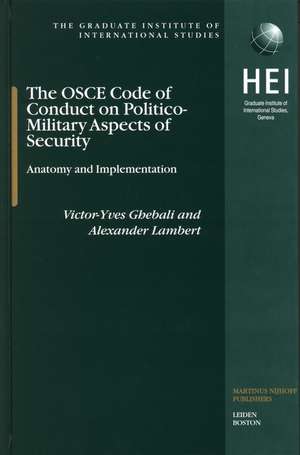The OSCE Code of Conduct on Politico-Military Aspects of Security: Anatomy and Implementation: Graduate Institute of International and Development Studies, cartea 5
Autor Victor-Yves Ghebalien Limba Engleză Hardback – 13 ian 2005
The book represents an urgently needed reference work on both the contents and the impact of the Code; drawing on as-yet unpublished materials, it offers a paragraph-by-paragraph commentary on the Code, as well as an in-depth assessment of implementation trends in the OSCE region.
Preț: 1058.61 lei
Preț vechi: 1290.99 lei
-18% Nou
Puncte Express: 1588
Preț estimativ în valută:
202.59€ • 219.98$ • 170.17£
202.59€ • 219.98$ • 170.17£
Carte indisponibilă temporar
Doresc să fiu notificat când acest titlu va fi disponibil:
Se trimite...
Preluare comenzi: 021 569.72.76
Specificații
ISBN-13: 9789004142923
ISBN-10: 9004142924
Pagini: 428
Dimensiuni: 155 x 235 x 34 mm
Greutate: 0.94 kg
Editura: Brill
Colecția Brill | Nijhoff
Seria Graduate Institute of International and Development Studies
ISBN-10: 9004142924
Pagini: 428
Dimensiuni: 155 x 235 x 34 mm
Greutate: 0.94 kg
Editura: Brill
Colecția Brill | Nijhoff
Seria Graduate Institute of International and Development Studies
Recenzii
'The continuing relevance of the Code cannot be doubted. As put by Jonathan Dean, Europe is better off with a violated Code than with no such instrument. One also has to keep in mind that the violation of a politically binding agreement is in principle as inadmissible as a violation of international law. Both create mutual expectations concerning future behaviour, and these have to be met. Summing up, I warmly recommend this book to all those actors who are involved in and committed to the implementation of the Code.'
Kees Homan in Helsinki Monitor, 2005.
'It is undoubtedly the quintessential guide to understanding the overall impact that the OSCE impact on Europe’s military security regimes.'
ASIL Newsletter UN21 Interest Group, June 2005.
Kees Homan in Helsinki Monitor, 2005.
'It is undoubtedly the quintessential guide to understanding the overall impact that the OSCE impact on Europe’s military security regimes.'
ASIL Newsletter UN21 Interest Group, June 2005.
Cuprins
List of Abbreviations,
Foreword to Part I by Ambassador Ján Kubiš, Secretary General of the OSCE,
Foreword to Part II by Ambassador Lamberto Zannier, Director, OSCE Conflict Prevention Centre,
General Introduction,
Part I – Paragraph-by-Paragraph Commentary on the Code of Conduct, Vincent Ghebali,
Title: “Code of Conduct on Politico-Military Aspects of Security”, Preamble, Section I. Reaffirmation of comprehensive security and cooperative security, and enunciation of the solidarity principle,
Section II. Reaffirmation of the commitment to cooperate against terrorism,
Section III. Reaffirmation of the equal value of the Helsinki Final Act’s principles and of the commitment of non-assistance to aggressor states,
Section IV. Security Rights and obligations of OSCE participating states,
Section V. Importance of the process of arms control, disarmament and CSBM,
Section VI. Reaffirmation of commitments to cooperate for conflict prevention and crisis management,
Section VII. Democratic control of armed forces,
Section VIII. Democratic use of armed forces,
Section IX. Implementation arrangements,
Section X. Final clauses, Bibliography,
Annexes to Part I,
Part II – Assessment of Implementation Trends of the Code of Conduct, Alexander Lambert,
Introductory Remarks,
1. Assessment Framework,
2. Thematic Analysis of the Information Exchange,
3. The Code’s Regime Evaluation,
Bibliography,
Annexes to Part II,
Index to Part I,
Index to Part II.
Foreword to Part I by Ambassador Ján Kubiš, Secretary General of the OSCE,
Foreword to Part II by Ambassador Lamberto Zannier, Director, OSCE Conflict Prevention Centre,
General Introduction,
Part I – Paragraph-by-Paragraph Commentary on the Code of Conduct, Vincent Ghebali,
Title: “Code of Conduct on Politico-Military Aspects of Security”, Preamble, Section I. Reaffirmation of comprehensive security and cooperative security, and enunciation of the solidarity principle,
Section II. Reaffirmation of the commitment to cooperate against terrorism,
Section III. Reaffirmation of the equal value of the Helsinki Final Act’s principles and of the commitment of non-assistance to aggressor states,
Section IV. Security Rights and obligations of OSCE participating states,
Section V. Importance of the process of arms control, disarmament and CSBM,
Section VI. Reaffirmation of commitments to cooperate for conflict prevention and crisis management,
Section VII. Democratic control of armed forces,
Section VIII. Democratic use of armed forces,
Section IX. Implementation arrangements,
Section X. Final clauses, Bibliography,
Annexes to Part I,
Part II – Assessment of Implementation Trends of the Code of Conduct, Alexander Lambert,
Introductory Remarks,
1. Assessment Framework,
2. Thematic Analysis of the Information Exchange,
3. The Code’s Regime Evaluation,
Bibliography,
Annexes to Part II,
Index to Part I,
Index to Part II.












